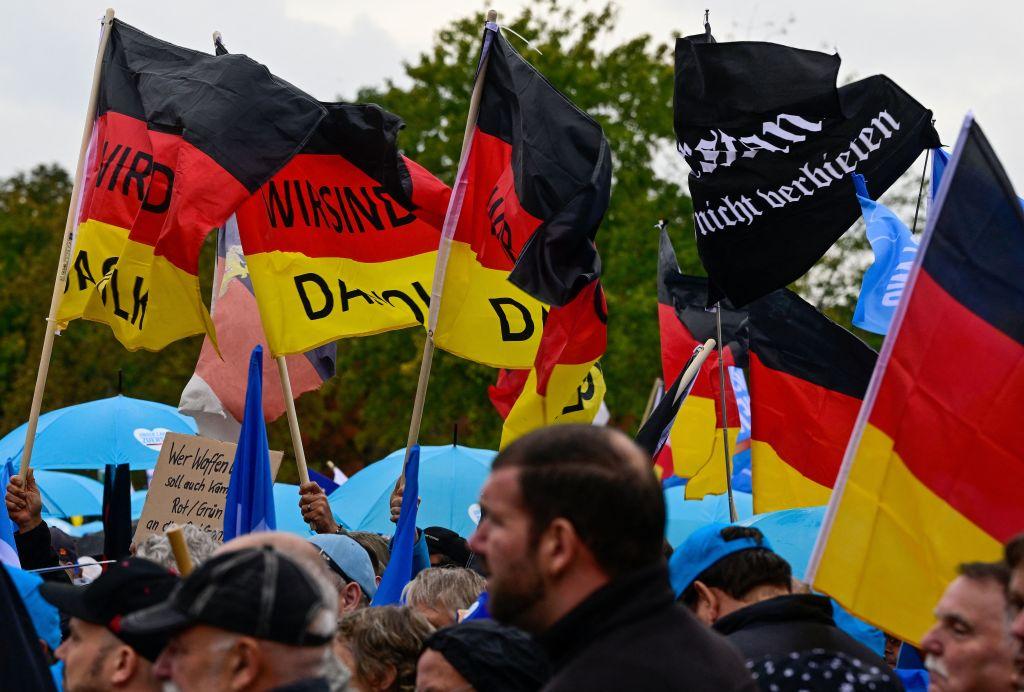
Over the past two years, Germany’s largest far-right party, Alternative for Germany (AfD), has managed to consolidate the numerous splinter groups that comprise the country’s long-unsettled nationalist fringe. Defying its reputation for infighting and frequent leadership turnovers, the AfD has come to be dominated by a single figure, Björn Höcke. While Germany’s political mainstream still treats the party as a pariah, the AfD is seeking to present itself as a united force ready to take on government responsibilities.
Höcke, who heads the AfD’s branch in Germany’s eastern state of Thuringia, rose to prominence as the spiritus rector of the party’s most extremist faction, known as der Flügel (the wing). That radical nationalist grouping—whose neo-Nazi rhetoric attracted the close scrutiny of the Bundesnachrichtendienst, Germany’s federal intelligence agency—was dissolved in 2020, and Höcke has become the de facto leader of an even more radical AfD.
How far to the right the AfD has shifted became evident during its recent party congress, held in the east German city of Magdeburg. Beyond addressing familiar themes, such as immigration control, Höcke offered new clues about the AfD’s agenda regarding the European Union, declaring, ‘This EU must die, so that the real Europe can live.’
The statement was reminiscent of Nazi slogans of the 1930s, which similarly advocated the destruction of an old system to enable the rise of a new, better one. And other AfD figures seem to be on board with it. The party’s lead candidate for next year’s European Parliament election, Maximilian Krah, said in a recent interview that the EU in its current form ‘is not viable’ and predicted that a ‘combination of disruption and reform’ would bring about its demise.
The party knows how effective a rightward shift can be for attracting popular support. For most of its existence, the AfD drew 9–14% of the electorate’s support in national polls. But its support briefly surged to nearly 20% around the time of the 2015 migrant crisis, when the party—founded two years earlier as an anti-euro party—played up its hardline anti-immigration stance.
The increase didn’t last, and the AfD was back to about 10% support within a year. But the Ukraine war—which disrupted not only Germans’ sense of security, but also their energy supply—seems to have given the AfD another boost. Before Russia’s full-scale invasion last year, the party was polling just 11% support. By late May of this year, however, that share had grown to 18%, and by August it reached 21%, making the AfD Germany’s second-largest party, after the Christian Democratic Union (CDU).
The question now is whether the AfD can retain its new supporters this time. So far, the party has been following the same playbook as before, capitalising on widespread alienation from other parties and focusing on its opponents’ weaknesses rather than its own strengths. It is showing a new sense of unity by closing ranks behind Höcke.
That is an effective strategy, because both of the AfD’s main opponents—the current coalition government and the CDU—have plenty of weaknesses. Start with the so-called traffic-light coalition (Ampelkoalition), comprising the Social Democratic Party (SPD), the Greens and the Free Democrats, with the SPD’s Olaf Scholz as chancellor.
Operating under the banner of ‘daring more progress’, the government has launched numerous reform initiatives since taking power in December 2021. But it has also been constantly in crisis mode, owing to the pandemic and the Ukraine war. And in confronting these challenges, Scholz’s administration has displayed a lack of professionalism rarely seen at the federal level in Germany.
For example, badly crafted reforms to modernise the energy sector left state governments, local authorities, businesses and voters confused about who is responsible for what, when and at what cost. After months of squabbling, the policy was put on hold until the autumn.
Efforts in other areas—such as national security, health care and infrastructure—have been similarly long on ambition and short on progress. And infighting has become the norm. Between the government’s ineptitude and broader popular anxiety about energy supplies, the economy and national security, the AfD has had plenty of political fodder.
Meanwhile, Friedrich Merz, the CDU chair and chancellor-in-waiting, has failed to position his party as a viable alternative to the SPD-led government. The CDU has also proved unable to win back the voters it lost to the AfD over its stance on immigration and issues such as gender identity and sexual orientation. As a result, popular support for the CDU has remained steady, at 28–30%, for more than a year.
For his part, Merz has made contradictory statements about the CDU’s relationship with the AfD, including whether local-level cooperation with elected AfD officials should be allowed. This has weakened his standing in the party, and challengers are already emerging.
The AfD, for its part, is still the party for those who are unhappy with the status quo and distrust mainstream politics, the party that opposes and criticises, but stands for little. But the failures of both the government and the opposition have emboldened its leaders, who are becoming hungrier for power as their popular support grows.
While the political cordon sanitaire that isolates the AfD still holds, one cannot ignore the possibility that the party could become not only a coalition partner, but even a coalition leader. That could well happen in the next two years in several eastern German states, where the AfD has long garnered well over 20% of the vote. In any case, unless Germany’s political mainstream gets its act together, it will be only a matter of time before the AfD—much like far-right parties in France, Italy and Sweden—is accepted as a legitimate party to hold government power.